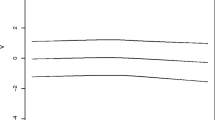Abstract
The relationship between variables in applied and experimental research is often investigated by the use of extreme (i.e., upper and lower) groups. Earlier analytical work has demonstrated that the extreme groups procedure is more powerful than the standard correlational approach for some values of the correlation and extreme group size. The present article provides methods for using the covariance information that is usually discarded in the classical extreme groups approach. Essentially, then, the new procedure combines the extreme groups approach and the correlational approach. Consequently, it includes the advantages of each and is shown to be more powerful than either approach used alone.
Similar content being viewed by others
References
Feldt, L. S. The use of extreme groups to test for the presence of a relationship.Psychometrika, 1961,26, 307–316.
Kelley, T. L.Fundamentals of statistics. Cambridge, Mass.: Harvard University Press, 1947.
McClelland, D. C. et al.The achievement motive. New York: Appleton-Century-Crofts, 1953.
Pearson, K. Mathematical contributions to the theory of evolution: XI. On the influence of natural selection on the variability and correlation of organs.Transactions of the Royal Society (London), 1903, Series A,200, 1–66.
Peters, C. C. A technique for correlating measurable traits with freely observed social behaviors.Psychometrika, 1941,6, 209–219.
Peters, C. C., & Van Voorhis, W. R.Statistical procedures and their mathematical bases. New York: McGraw-Hill, 1940.
Taylor, J. A. Drive theory and manifest anxiety.Psychological Bulletin, 1956,53, 303–320.
Thorndike, R. L.Personnel selection. New York: Wiley, 1949.
Author information
Authors and Affiliations
Rights and permissions
About this article
Cite this article
Alf., E.F., Abrahams, N.M. The use of extreme groups in assessing relationships. Psychometrika 40, 563–572 (1975). https://doi.org/10.1007/BF02291557
Received:
Revised:
Issue Date:
DOI: https://doi.org/10.1007/BF02291557




